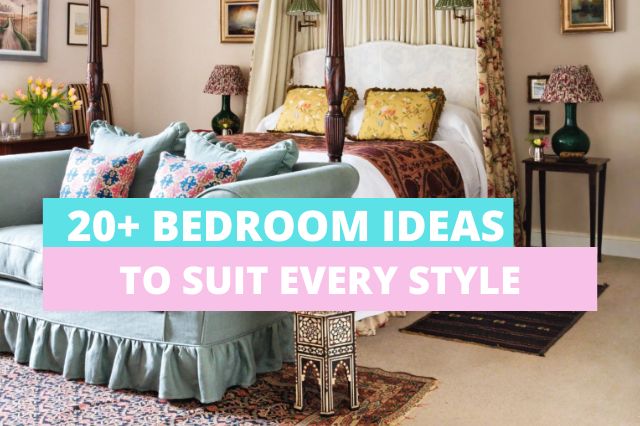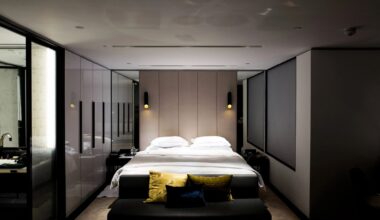Transform your home into a showstopper with insider tips from top professional home stagers. These experts know exactly how to accentuate your home’s assets, conceal any imperfections, and make it appealing to a wide range of potential buyers or guests.
We’ve scoured the country to bring you the best budget-friendly tips to spruce up each room in your home.
From adding statement pieces to maximizing small spaces, these tips are sure to inspire you and transform your home into the stylish haven you’ve always wanted. Get ready to take notes and let’s dive into the world of decorating.
The Tone at The Front Door
:no_upscale()/cdn.vox-cdn.com/uploads/chorus_asset/file/21714438/BN9G32.jpg)
Start strong with a stunning front door! Make a lasting impression with a bold, glossy paint color like red, orange, or yellow. These hues are believed to symbolize luck, joy, and warmth.
Lara Allen-Brett, a New Jersey-based stager, suggests opting for a classic red front door to welcome guests with traditional hospitality. Meanwhile, San Francisco-based stager Christopher Breining notes that orange and yellow are rising in popularity for their cheerful energy.
Say goodbye to outdated screen doors and upgrade to a storm door with full-length glass that can be easily switched for a screened panel. Create a striking entrance that sets the tone for the rest of your home.
Bring Light Into Your Rooms

Bring brightness and warmth into your home with lighting! As Jo Bailey, Homes & Gardens’ Deputy Editor and stylist, points out, having as much natural light as possible is crucial for successful home decor.
Maximize daylight by opting for light colors and decluttering, and reconsider bulky curtain ideas.
But don’t forget about artificial lighting either. Make sure every room has a well-balanced mix of ambient, accent, and task lighting. Avoid relying on a single overhead bulb, and create a warm and inviting atmosphere with smart lighting solutions.
Foundation of Enduring Pieces

When it comes to decorating, think of your room as several distinct layers. The base layer should consist of your largest pieces of furniture, the ones you’ll take with you from home to home.
The second layer includes smaller pieces of furniture. And the third layer is comprised of textiles and accessories, which are more versatile and can be changed as you move from one home to another.
Interior Designer and owner of August Black Interior Design, Charli Hantman, emphasizes the importance of having layers in a room. “Core elements like a sofa, coffee table, and rug form the foundation and anchor the space.
Secondary furniture pieces, decorative objects, textiles, and art are the elements that bring warmth and personal style to your home.”
Curate Your Clutter
:max_bytes(150000):strip_icc():format(webp)/decorating-tips-7-post-company-the-sandman-fa871f5b17ac4e10b3cd65c20b1b0d79.jpeg)
Many interior designers stress the importance of decluttering, but it doesn’t have to mean embracing minimalism. “For me, ‘less is more’ is not just about minimalism, but more about curation,” says Mona Ying Reeves, founder of Bay Area design firm Remodern. “When you bring more intention into curating a space through décor choices, you end up with rooms that have meaning, feel genuine, and endure passing trends.”
So don’t just get rid of items for the sake of decluttering. Instead, focus on keeping items that hold sentimental value and bring joy to your home. Create spaces that reflect who you are and your personal taste.
Revamp Your Kitchen Windows with Style

Bring the beauty of natural light into your kitchen with the right window treatments. Say goodbye to outdated heavy drapes and hello to sheer shades paired with full-length panels that not only let the sunshine in but also add an elegant touch to the room.
When choosing the fabric, opt for light colors that won’t fade in the sun, and for a smooth and sleek look, cotton, linen, or silk blends are the most recommended options.
Create a Mood with Color

Color sets the tone for a room. Choose hues that match your personal style and the mood you want to create.
For a calm and relaxed feel, opt for cool colors like blues and greens. For a warm and inviting atmosphere, choose warm colors like yellows and reds.
Don’t be afraid to make a statement with an accent wall or a bold piece of furniture. But remember, too much color can be overwhelming, so balance it with neutral shades.
Mix and Match Different Textures

Mixing and matching different textures in your home decor can add depth, interest, and visual appeal. This can be achieved by combining textures in flooring, walls, furniture, and accessories.
Layering textured elements like plush rugs, exposed brick walls, wooden furniture, knit blankets, velvet pillows, and ceramic vases can help create a dynamic and visually appealing space.
Anchor Rugs Under Furniture Feet

When choosing a rug, it is important to make sure it is large enough to fit under all or at least the front legs of the furniture in the seating area.
This helps to define the space and bring all the pieces together. The recommended size for a living room is an 8-by-10-foot or a 9-by-12-foot rug.
Scale Artwork to Your Wall
:no_upscale()/cdn.vox-cdn.com/uploads/chorus_asset/file/21727534/0314254.jpg)
It’s important to keep the scale of the artwork in proportion to the wall it’s hanging on. A large wall calls for oversize pieces or multiple pieces grouped together in a gallery style with a consistent 2-4 inch spacing between them.
Art should hang at eye level, with the middle of the piece at the average height of people in the room. Avoid hanging dinky art too high on the wall as it can look ridiculous.
Don’t Display Everything at the Same Height

Varying the height of décor items creates visual interest and makes your space look more dynamic and less static. Mixing up tall, short, and medium-sized pieces in a room will create a more natural, organic feel and bring a sense of balance to the space.
So, don’t be afraid to mix and match heights when hanging art, placing furniture, or displaying accessories.
Invest in Matching Hardware
A kitchen is often the first place you think of when you hear “hardware,” but the same concept applies to other rooms in your home as well. From bathroom cabinets to bedroom dressers, cohesive hardware can pull a space together and make it look more polished.
“When hardware is cohesive, it makes a room feel intentional and well thought out,” says Sara Gilbane, interior designer and founder of Sara Gilbane Interiors. “Whether you’re mixing and matching metal finishes or opting for one uniform finish, a consistent hardware scheme can elevate the look of your space.”
Use Visual Tricks to Raise The Ceiling
If your ceilings are low, paint them white to make the room feel more spacious. Hang curtains higher than the windows to create an illusion of height. Vertical stripes on curtains can also elongate the walls visually.
Leaning a large mirror against a wall can also make a room appear taller. Ordering custom drapes can also allow you to hang curtains higher.
Final Thoughts
In conclusion, home decor and design can be a fun and rewarding experience. Whether you are starting from scratch or revamping an existing space, there are many ways to bring style and comfort to your home.
From layering lighting, playing with textures, anchoring rugs, scaling artwork, and switching up switch plates, these tips will help you create a warm and inviting space that reflects your personality and style.
Additionally, small visual tricks such as raising the curtains or using a large mirror can have a big impact on the overall look and feel of a room. Remember, home decor is not just about aesthetics, it’s about creating a space that is functional, comfortable, and makes you happy.




